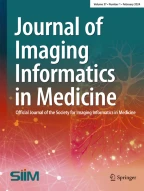Abstract
We examined the potential of the iPad 2 as a teleradiologic tool for evaluating brain computed tomography (CT) with subtle hemorrhage in the conventional lighting conditions which are common situations in the remote CT reading. The comparison of the clinician’s performance was undertaken through detecting hemorrhage by the iPad 2 and the clinical liquid crystal display (LCD) monitor. We selected 100 brain CT exams performed for head trauma or headache. Fifty had subtle radiological signs of intracranial hemorrhage (ICH), while the other 50 showed no significant abnormality. Five emergency medicine physicians reviewed these brain CT scans using the iPad 2 and the LCD monitor, scoring the probability of ICH on each exam on a five-point scale. Result showed high sensitivities and specificities in both devices. We generated receiver operating characteristic curves and calculated the average area under the curve of the iPad 2 and the LCD (0.935 and 0.900). Using the iPad 2 and reliable internet connectivity, clinicians can provide remote evaluation of brain CT with subtle hemorrhage under suboptimal viewing condition. Considering the distinct advantages of the iPad 2, the popular out-of-hospital use of mobile CT teleradiology would be anticipated soon.
Similar content being viewed by others
References
Flanders AE, Wiggins 3rd, RH, Gozum ME: Handheld computers in radiology. Radiographics 23(4):1035–1047, 2003
Choi HJ, Lee JH, Kang BS: Remote CT reading using an ultramobile PC and web-based remote viewing over a wireless network. J Telemed Telecare 18:26–31, 2012
Kim DK, Kim EY, Yang KH, Lee CK, Yoo SK: A mobile tele-radiology imaging system with JPEG2000 for an emergency care. J Digit Imaging 24:709–718, 2011
IDC: Apple will maintain dominance in the media tablet market in 2011 as demand continues to soar in EMEA. Available at http://www.idc.com/getdoc.jsp?containerId=prUK23046011. Accessed 8 January 2013
Displaymate. Apple iPad 2 LCD display shoot-out. Available at http://www.displaymate.com/Tablet_ShootOut_2.htm. Accessed 8 January 2013
McLaughlin P, Neill SO, Fanning N, et al: Emergency CT brain: preliminary interpretation with a tablet device: image quality and diagnostic performance of the Apple iPad. Emerg Radiol 19:127–133, 2012
Johnson PT, Zimmerman SL, Heath D, Eng J, Horton KM, Scott WW, Fishman EK: The iPad as a mobile device for CT display and interpretation: diagnostic accuracy for identification of pulmonary embolism. Emerg Radiol 19(4):323–327, 2012
McNulty JP, Ryan JT, Evanoff MG, Rainford LA: Flexible image evaluation: iPad versus secondary-class monitors for review of MR spinal emergency cases, a comparative study. Acad Radiol 19(8):1023–1028, 2012
Badano A, Flynn MJ, Kanicki J: High-Fidelity Medical Imaging Displays. SPIE, Washington, DC, 2004
Yaghmai V, Salehi SA, Kuppuswami S, Berlin JW: Rapid wireless transmission of head CT images to a personal digital assistant for remote consultation. Acad Radiol 11:1291–1293, 2004
Tintinalli JE, et al: Tintinalli’s Emergency Medicine: a Comprehensive Study Guide, 7th edition. New York: The McGraw-Hill, 2011
Reponen J, Ilkko E, Jyrkinen L, Tervonen O, Niinimäki J, Karhula V, Koivula A: Initial experience with a wireless personal digital assistant as a teleradiology terminal for reporting emergency computerized tomography scans. J Telemed Telecare 6:45–49, 2000
iPad’s technical specifications. Available at http://www.apple.com/ipad/specs. Accessed 8 January 2013
Oleg S: Pianykh: Digital Imaging and Communications in Medicine (DICOM): a Practical Introduction and Survival Guide. Springer, Berlin, 2008
National Electrical Manufacturers Association: Part 14: Grayscale Standard Display Function in Digital Imaging and Communications in Medicine (DICOM), Virginia. 2004
ACR (American College of Radiology) Technical standard for electronic practice of medical imaging resolution 13–2007. Available at http://www.acr.org/~/media/ACR/Documents/PGTS/standards/ElectronicPracticeMedImg.pdf. Accessed 8 January 2013
Homepage of the RemoteView. Available at https://www.rview.com. Accessed 8 January 2013
Homepage of the iTunes. Available at http://www.apple.com/itunes. Accessed 8 January 2013
RemoteView Mobile iPhone/iPad User Guide. Available at http://rsupport.com/upload/Download/RemoteView-iPhone-UserGuide-en-US.pdf. Accessed 8 January 2013
Hawass NE: Comparing the sensitivities and specificities of two diagnostic procedures performed on the same group of patients. Br J Radiol 70(832):360–366, 1997
Hillis SL, Berbaum KS, Metz CE: Recent developments in the Dorfman–Berbaum–Metz procedure for multireader ROC study analysis. Acad Radiol 15:647–661, 2008
Altman DG: Practical Statistics for Medical Research. Chapman and Hall, London, 1991
Displaymate. Tablet displays under bright ambient lighting shoot-out. Available at http://www.displaymate.com/Tablet_Brightness_ShootOut_1.htm. Accessed 8 January 2013
Yoshimura K, Shimamoto K, Ikeda M, Ichikawa K, Naganawa S: A comparative contrast perception phantom image of brain CT study between high-grade and low-grade liquid crystal displays (LCDs) in electronic medical charts. Phys Med 27(2):109–116, 2011
Rosset A, Spadola L, Ratib O: OsiriX: an open-source software for navigating in multidimensional DICOM images. J Digit Imaging 17:205–216, 2004
Choudhri AF, Radvany MG: Initial experience with a handheld device digital imaging and communications in medicine viewer: OsiriX mobile on the iPhone. J Digit Imaging 24:184–189, 2011
Image transfers, OsiriX HD User Manual. Available at http://www.osirix-viewer.com/Manual/#ImagesTransfers. Accessed 8 January 2013
John S, Poh AC, Lim TC, Chan EH, Chong LR: The iPad tablet computer for mobile on-call radiology diagnosis? Auditing discrepancy in CT and MRI reporting. J Digit Imaging 25(5):628–634, 2012
Author information
Authors and Affiliations
Corresponding author
Rights and permissions
About this article
Cite this article
Park, J.B., Choi, H.J., Lee, J.H. et al. An Assessment of the iPad 2 as a CT Teleradiology Tool Using Brain CT with Subtle Intracranial Hemorrhage Under Conventional Illumination. J Digit Imaging 26, 683–690 (2013). https://doi.org/10.1007/s10278-013-9580-0
Published:
Issue Date:
DOI: https://doi.org/10.1007/s10278-013-9580-0
